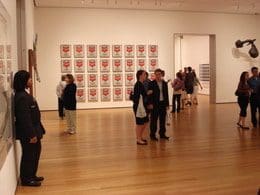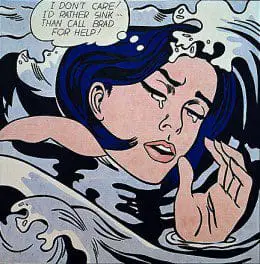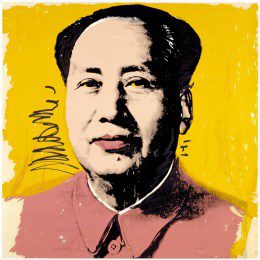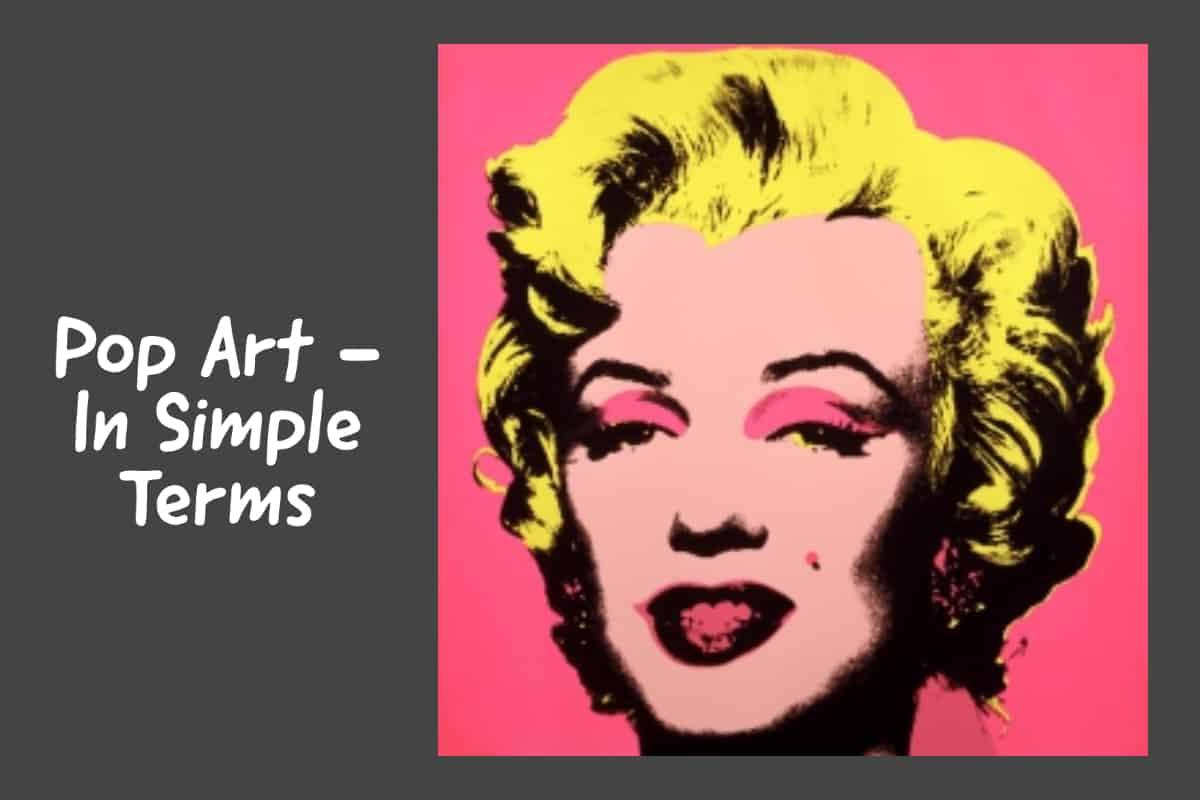One of my favorite art forms has always been pop art. Maybe it’s because use images and objects that are familiar.
Pop Art uses imagery from advertising, comic books, and other mass-produced cultural objects. Pop Art was seen as a reaction to the Abstract Expressionism art movement. Pop Artists would purposefully use familiar mass culture images. Many times the Pop Artists made artistic statements about world events in their Pop Art.
Table of Contents
- Pop Art – In Simple Terms
- What Is The Importance Of Pop Art?
- Frequently Asked Questions
- Related Questions

Pop Art – In Simple Terms
Pop art is an art movement that emerged in the United Kingdom and the United States in the mid to late 1950s. The movement challenged the traditional fine art of its day by using imagery from popular and mass culture. The Pop artist took popular imagery from advertising, comic books, and other mass-produced cultural objects and turned them into art.
Pop art was seen as a reaction to the then-dominant art movement of abstract expressionism. Because Pop Art used many found objects and images, it was similar to the Dada or Dadaism avant-garde art movement in Europe in the early 20th Century.
Pop Art and Minimalism Art Movements are considered the art movements that preceded the postmodern art movement. In fact, some of the Pop Art is thought to be early examples of the postmodern art movement.
In their time, some of the top pop artists were Andy Warhol, Roy Lichtenstein, Richard Hamilton, Edward Hopper, James Gill, Robert Indiana, Jasper Johns, Claes Oldenburg, Robert Rauschenberg, and Tom Wesselmann. Through their pop art, these artists were all questioning some of the elitist culture and fine art traditions of this time in their artwork.
Although Pop Art started in the 1950s, it really came about as an accepted art movement in the 1960s and 1970s.
What Are The Main Themes Of Pop Art?
I am themes of pop art to use imagery that was currently used in advertising—product labeling on logos and other figures prominently placed in the pop artist’s images. An example of this was Andy Warhol and his labels of the Campell soup cans. This was an everyday object that he made into art.
Pop Artists usually used saturated colors and bold outlines in their artwork. Part of their work’s purpose was to show the optimism, influence, materialism, and consumption of the post-World War II era. That’s why pop art is known for brighter colors that instantly grab the audience’s attention.

What Makes Pop Art Unique?
What made Pop Art unique was that the uniqueness of the art was abandoned and it was replaced by mass production. For example, in Pop Art, an artist may replicate images many times over using different colors and sizes. This was something that had never been seen in art before.
The Pop Artists Roy Lichtenstein said this about Pop Art
“Pop Art looks out into the world. It doesn’t look like a painting of something, it looks like the thing itself.”
Roy Lichtenstein
What Is The Importance Of Pop Art?
Pop Art helped blur the boundaries of art between what was seen as “high” art or high society and “low” or mass culture. As Pop Art blurred these boundaries, it also helps the art serve as an equalizer of society.
Pop art took for its concept that there is no hierarchy in culture or art and that art can borrow from any source. And borrow from any source that is exactly what the Pop Artists did.
Pop art was also a commentary on world events and the consumerism of its day. In many ways, it reflected what was happening in the world during the 1960s and 1970s. During the 1960s and 1970s, America and Europe saw huge cultural shifts in fashion, music, lifestyle choices, etc.
In speaking of how society had become more equalized for the masses and cultural changes taking place, Andy Warhol said:
“What’s great about this country is that America started the tradition where the richest consumers buy essentially the same things as the poorest. You can be watching TV and see Coca-Cola, and you can know that the President drinks Coke. Liz Taylor drinks Coke, and just think, you can drink Coke, too.”
Andy Warhol

What Is Pop Art Today?
Some say that pop art did not go past the 1970s era. But the truth is that pop art is still around today.
They are still artists today who are producing contemporary art, which is influenced by pop art. Also, today, artists are producing works of art that are a commentary on world events and the consumerism culture we live in – all things that Pop Art also influences.
Today, with the onset of Digital Art, many artists are influenced by pop art. So it can be said that pop art is still very relevant today and still be produced today.
For its time, Pop Art was a very daring art movement. It went against all the other art movements that were taking place during this time frame. That is one of the reasons why Pop Art is still such a relevant art movement today.
Anita Louise Art is dedicated to art education, great artists, and inspiring others to find and create their art. We love art that uplifts and inspires. #ArtToMakeYouSmile! #ArtToMakeYouHappy!
If you are interested in seeing any of my art, you can find out more by clicking here. If you are interested in what inspires me and my paintings, you can discover more by clicking here.
We have a free newsletter and would love you to be part of our community; you can subscribe to the newsletter by clicking here. I would be happy to talk to you if you have any questions. You can reach me, Anita, by clicking here.
Subscribe to our Anita Louise Art YouTube Channel filled with great videos and information by clicking here.
Join us for our podcast “5 Minutes With Art.” Spend 5 minutes a week with us to discover and learn about great art and artists. You can find out more about our podcast by clicking here.
Frequently Asked Questions
What is Pop Art?
Pop Art is an art movement that emerged in the 1950s and 1960s. It uses images and objects from popular culture, such as advertising, comic books, and everyday items, to create art.
Why is it called “Pop” Art?
The term “Pop” in Pop Art stands for “popular.” This art form draws inspiration from popular culture and mass media, making it accessible to a wider audience.
How did Pop Art originate?
Pop Art originated as a reaction to the Abstract Expressionism movement. Artists wanted to move away from the seriousness of abstract art and instead focus on the everyday imagery that surrounded them.
What types of images does Pop Art use?
Pop Art uses images from mass-produced cultural objects, including advertisements, consumer products, celebrities, and comic books. Artists often incorporated familiar and easily recognizable symbols.
Who were some famous Pop Artists?
Notable Pop Artists include Andy Warhol, Roy Lichtenstein, Claes Oldenburg, and Jasper Johns. Warhol, in particular, is famous for his iconic Campbell’s Soup Cans and Marilyn Monroe portraits.
How did Pop Artists make statements about world events?
Pop Artists often used their work to comment on social and political issues. For example, they might incorporate images related to war, consumerism, or celebrity culture, providing a commentary on the contemporary world.
Is there a specific style associated with Pop Art?
Yes, Pop Art is characterized by its bold and vibrant colors, use of mass-produced imagery, and often a sense of irony or satire. The style varies among artists, but a common thread is the incorporation of popular culture elements.
Did Pop Art have a significant impact on the art world?
Yes, Pop Art had a profound impact on the art world. It challenged traditional notions of fine art and introduced a more accessible and relatable form of artistic expression.
How did Pop Art affect everyday perceptions of art?
Pop Art played a crucial role in breaking down barriers between high and low culture. It made art more relatable to everyday people by incorporating familiar images, bridging the gap between fine art and popular culture.
Is Pop Art still relevant today?
Yes, Pop Art continues to be influential and relevant in contemporary art. Many contemporary artists draw inspiration from Pop Art, and its impact can be seen in various forms of visual culture, including design, fashion, and advertising.
Related Questions
What Was the Relationship Between Berthe Morisot and the Manet Brothers?
Edouard Manet, Berthe Morisot, and Eugene Manet all lived in France in the mid-1800s. Both Edouard and Berthe are considered to be significant impressionist artists. Edouard met Berthe when he married Suzanne, his former piano tutor. Berthe and Edouard were lifelong friends, and she was considered his muse. Eventually, Berthe married Edouard’s younger brother Eugene, and they had one daughter named Julie.
You can read more about this by reading our blog Berthe Morisot and the Manet Brothers – Love And Impressionist Art by clicking here.
Who are 7 Of The Most Important Women Impressionist Artists?
The seven significant women of impressionist painters are Berthe Morisot, Mary Stevenson Cassatt, Marie Bracquemond, Louise Catherine Breslau, Eva Gonzales, and Lilla Cabot Perry. In their unique ways, Each of these women contributed to impressionism art.
You can read our blog post 7 Women Impressionist Artists, To Admire, Know, and Remember by clicking here.


